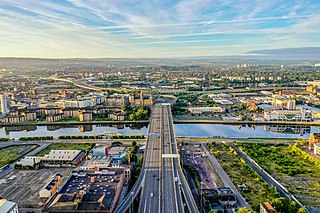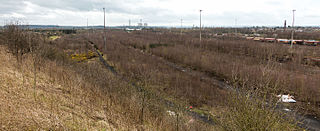Related Research Articles

Thames Gateway is a term applied to an area around the Thames Estuary in the context of discourse around regeneration and further urbanisation. The term was first coined by the UK government and applies to an area of land stretching 70 kilometres (43 mi) east from inner east and south-east London on both sides of the River Thames and the Thames Estuary. It stretches from Westferry in Tower Hamlets to the Isle of Sheppey/Southend-on-Sea and extends across three ceremonial counties.

The A20 is a major road in south-east England, carrying traffic from London to Dover in Kent. Parts of the route date back to turnpikes established in the early part of the 18th century. The line of the road throughout Kent runs closely in parallel with the M20 motorway.

The Borough of Maidstone is a local government district with borough status in Kent, England. Its administrative centre is Maidstone, the county town of Kent.

The Thames Gateway Bridge was a proposed crossing over the River Thames in east London, England. It was first mooted in the 1970s but never came to fruition. The concept was re-proposed in 2004, with preliminary planning proceeding until November 2008, when Boris Johnson, the then Mayor of London, formally cancelled the entire £500 million scheme.

Bearsted is a village and civil parish with railway station in mid-Kent, England, two miles (3.2 km) east of Maidstone town centre.

Hollingbourne is a village and civil parish in the borough of Maidstone in Kent, England. The parish is located on the southward slope of the North Downs to the east of the county town, Maidstone. The parish population is around 900 and has three conservation areas: Upper Street in the village centre and the outlying hamlets of Broad Street and Eyhorne Street.

Thurnham is a village and civil parish which lies at the foot of the North Downs 3 miles (4.8 km) north east of Maidstone in the Borough of Maidstone and ceremonial county of Kent in England. It had a population of 1,085 in 2001 including Weavering, which increased to 1,205 following the 2011 Census.

Ruskin Square is a project to redevelop a parcel of land between East Croydon railway station and the existing town centre of Croydon in South London. It is part of the major Croydon Vision 2020 regeneration scheme. It has been subject to substantial public debate which has featured in the national media.

The city of Glasgow, Scotland has a transport system encompassing air, rail, road, and an underground rail line. Prior to 1962, the city was also served by trams. Commuters travelling into Glasgow from the neighbouring local authorities of North and South Lanarkshire, Renfrewshire, East Renfrewshire, and East and West Dunbartonshire have a major influence on travel patterns, with tens of thousands of residents commuting into the city each day. The most popular mode of transport in the city is the car, used by two thirds of people for journeys around the city.

Old Oak Common (OOC) is a railway station under construction on the site of the Old Oak Common traction maintenance depot to the west of London in Old Oak Common, approximately 1⁄3 mile (0.54 km) south of Willesden Junction station. When built, it is expected to be one of the largest rail hubs in London, at about 1⁄2 mile (0.80 km) in length and 65 feet (20m) below surface level.
The Lower Thames Crossing is a proposed road crossing of the Thames estuary close to the Dartford Crossing that links the counties of Kent and Essex, and its proposed approaches. If built it would also pass through the district of Thurrock however on the Kent side would pass through Gravesham to cut through the North Downs, supplementing the Dartford route. The approximate 14.3 miles (23.0 km) route will soon be assessed by the Planning Inspectorate.

A potential Thames Estuary Airport has been proposed at various times since the 1940s. London's existing principal airports, Heathrow, Gatwick and Stansted, are each sub-optimally located in various ways, such as being too close to built-up areas or requiring aircraft to fly low over London. In the case of Heathrow, the growth of air traffic has meant that the airport is operating at 98% capacity. Several locations for a new airport have been proposed in the Thames Estuary, to the east of London. These include Maplin Sands off Foulness on the north side of the estuary; Cliffe and the Isle of Grain in Kent on the south side; and artificial islands located off the Isle of Sheppey such as the "Boris Island" proposal championed by Boris Johnson, the then Mayor of London. Economic considerations have so far ruled out a new coastal airport, while political considerations have ruled out a new inland airport, leaving planners with an as-yet-unresolved dilemma.
KIG may refer to either one of these things:
The Thames Hub is a proposal for a new approach to integrated infrastructure development that combines rail, intermodal freight logistics, aviation, tidal renewable energy and its transmission, flood protection and regional development in the Thames Estuary and connects this infrastructure to a trade and utilities spine that runs the length of the UK. It was developed by architects Foster + Partners, infrastructure consultants Halcrow and economists Volterra and launched by Lord Foster at the Institution of Civil Engineers in London on 2 November 2011.
Wakefield Europort is a rail-connected warehousing and industrial estate located to the northeast of Wakefield at junction 31 of the M62 motorway in West Yorkshire, England. It opened in 1996 in anticipation of increased international railfreight due to the construction of the Channel Tunnel. As of 2012 the site employs over 3,000 persons, and has motorway, high capacity rail, and waterway (canal) transport access.
Doncaster iPort or Doncaster Inland Port is an intermodal rail terminal; a Strategic Rail Freight Interchange, under construction in Rossington, Doncaster at junction 3 of the M18 motorway in England. It is to be connected to the rail network via the line of the former South Yorkshire Joint Railway, and from an extension of the former Rossington Colliery branch from the East Coast Main Line.
WestConnex is a 33-kilometre (21 mi) predominantly underground motorway scheme in Sydney, New South Wales, Australia. As of 2021, it is partially completed and partially still under construction. A joint project of the New South Wales and Australian governments, the motorway scheme will create around 26 kilometres (16 mi) of new tunnels between Homebush and Kingsgrove, passing underneath Inner West suburbs including Haberfield and St Peters. The first of the tunnels, the M4 East, opened to traffic in July 2019. The second of the tunnels, the M8 Motorway, opened to traffic a year later in July 2020. The rest of the tunnels are expected to open to traffic in 2023.

East Midlands Hub was a planned new railway station on the Leeds Branch of High Speed 2. It was intended to be located on the existing railway sidings in Toton, situated between Nottingham and Derby. The station would have been located adjacent to the M1 motorway in Nottinghamshire, on the border with Derbyshire.

Manchester Interchange is a planned High Speed 2 station at Manchester Airport, on the southern boundary of Manchester, England, next to Junction 5 of the M56 motorway on the northern side of the airport 1.5 miles (2.4 km) north-west of Manchester Airport railway station. Manchester Airport is the busiest airport in the UK outside London and offers more destinations than any other British airport. An airport station was recommended by local authorities during the consultation stage. The government agreed in January 2013 for an airport station, but only on the basis that private investment was involved, such as funding from the Manchester Airports Group to build the station. The Government approved the scheme in November 2016.

The Sydney Gateway is an under-construction major road interchange between the WestConnex and the airport terminals of Sydney Airport. Construction began in early 2021 and is expected to open in December 2024. It was originally planned to open in late 2023 in conjunction with the M4–M5 Link. The Sydney Gateway will also be constructed in conjunction with the duplication of the nearby Port Botany freight rail line, which is managed by the Australian Rail Track Corporation.
References
- 1 2 "Kent International Gateway freight depot plan refused". BBC News Online. 5 August 2010. Retrieved 8 August 2010.
- ↑ Planning Application at Maidstone Borough Council (2007)
- 1 2 3 Freight depot battle stepped up, BBC News, 29 October 2007
- ↑ Guidance on Rail Freight Strategy, FreightOnRail.org.uk, accessed December 2008
- 1 2 MPs urged to drop support for KIG, by Paul Francis, Kent Messenger, 21 May 2008
- ↑ Letter from Department for Communities and Local Government, 5 August 2010 Archived 28 July 2011 at the Wayback Machine
- 1 2 Stop KIG Archived 13 October 2007 at the Wayback Machine Campaign Group Website (2008)
- ↑ Save Bearsted! Campaign Website
- ↑ Campaign to Protect Rural England website
- ↑ Is there any room?, LogisticsManager.com, 1 April 2008
- ↑ Government urged to support KIG Bexley Extra 4 April 2008